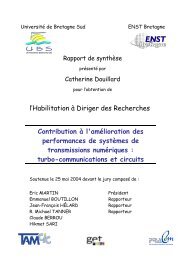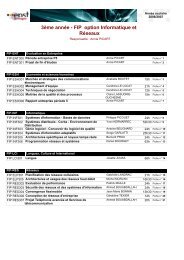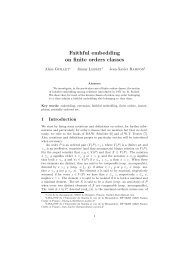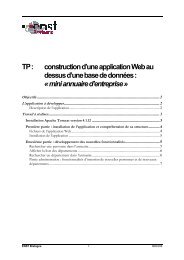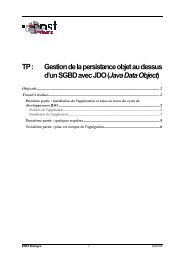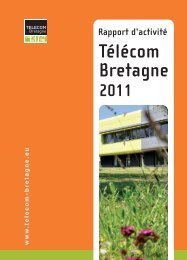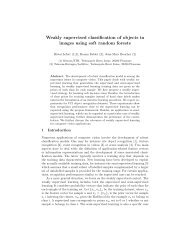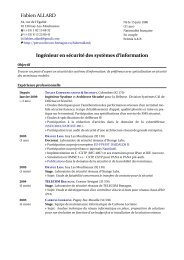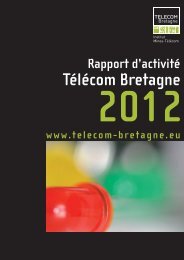researResearch - Télécom Bretagne
researResearch - Télécom Bretagne
researResearch - Télécom Bretagne
Create successful ePaper yourself
Turn your PDF publications into a flip-book with our unique Google optimized e-Paper software.
h Research<br />
9<br />
RESEARCH<br />
Main achievements of the project<br />
On the whole, we have seen a growing amount of<br />
expertise among the researchers on the UT<br />
project. The breadth of our research network has<br />
grown, both institutionally (Organisation for<br />
Economic Co-operation and Development,<br />
Council of Europe, Ministry of National Education)<br />
and contractually (National Agency for Research,<br />
Haute Autorité de Santé, Telecom Institute, region<br />
of Brittany, Marsouin, Images and Networks<br />
research cluster, ...).<br />
Regulation<br />
2008 was marked by a great deal of reform with<br />
respect to the legal frameworks surrounding<br />
electronic communications and audiovisual.<br />
Analyzing the content of these reforms, as well as<br />
what is at stake on a European scale, is at the very<br />
heart of all the other research activities,<br />
particularly those that deal with the area of use.<br />
For this reason, the new community directive on<br />
the services of audiovisual media was dealt with in<br />
a commentary that underlines the adaptation of<br />
the preexisting text (the directive 'Television<br />
without borders') to the emergence of new<br />
services and uses, particularly in the context of<br />
the development of non-linear services or videoon-demand<br />
services ([6]Blandin, in Journal du<br />
Droit Européen).<br />
With respect to the reform of the institutional<br />
regulations regarding electronic communications,<br />
the analysis paid particular attention to the<br />
institutional aspects, where the stakes appear to<br />
be especially high. Through various initiatives, the<br />
most emblematic of which was the project to<br />
create a European regulator, the European<br />
Commission declared its wish to refocus the<br />
regulations around itself and to reinforce the<br />
power that it holds. This is particularly the case<br />
when considering measures that national<br />
regulators take with respect to powerful<br />
operators, power that they would be called on to<br />
spread to the competitive remedies imposed ([5]<br />
Blandin, in Communications et Stratégies).<br />
In terms of services and uses, the various projects<br />
made it possible to find legal solutions, with the<br />
goal of managing emerging architectures and<br />
services, and at the same time, of moving the<br />
reflection forward on new legal and economic<br />
models whose formalization, and possibly<br />
experimentation, appear necessary.<br />
Localization<br />
Our central research question had to do with<br />
"industries and territories", but in the general<br />
economic sense of the English word industry,<br />
rather than the more precise meaning of the<br />
French term industrie.<br />
The research on the evaluation and analysis of the<br />
dynamics of territorial industries in emerging<br />
countries, particularly in China, was carried out<br />
(Béraud, for ISMEA). Territorial industries are<br />
defined as activities with a limited location<br />
(limited by natural resources, institutions...). We<br />
carried out the analysis of links between<br />
economic dynamics, investment, and the<br />
development of territorial industries in China,<br />
across urban networking services. The analysis<br />
reveals different business systems for different<br />
types of networks.<br />
The use of ICT often has counterintuitive effects<br />
on the location of users, effects that are reinforced<br />
as learning by doing complicates the models and<br />
use scenarios. This is why we undertook an<br />
empirical study ([3] Le Goff-Pronost, Lethiais, in<br />
Revue d’Economie Régionale et Urbaine whose<br />
goal was to determine whether or not the need for<br />
geographical proximity between a business and<br />
its partners remained one of the explanatory<br />
factors of the agglomeration phenomenon that we<br />
continue to observe, despite the growing diffusion<br />
of ICT. We reached the inevitable conclusion that<br />
these technologies are not simply tools allowing<br />
the transfer of codified knowledge. They must also<br />
be seen as a way to exchange information and<br />
coordinate with one's partners remotely.<br />
We took on the question of the information needs<br />
of companies vs. their coordination needs in a<br />
deeper way by studying the ICT adoption and use<br />
behaviors of businesses located in an<br />
environment of weak economic density (Lethiais<br />
et al., in Revue d’économie industrielle). The goal<br />
was to analyze the links between organizational<br />
and environmental characteristics of rural<br />
businesses and uses in order to demonstrate the<br />
nature of their communication needs. The<br />
research demonstrates that how much ICT is used<br />
depends more on the specific characteristics of<br />
the companies themselves than on those of their<br />
environment. These factors differ depending on<br />
the nature of the needs they address, whether<br />
129



